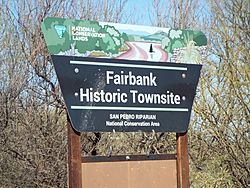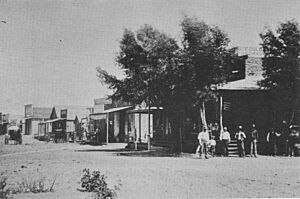Fairbank, Arizona facts for kids
Quick facts for kids
Fairbank, Arizona
|
|
|---|---|

Fairbank Historic Townsite
|
|
| Country | United States |
| State | Arizona |
| County | Cochise |
| Founded | May 16, 1883 |
| Abandoned | 1970s |
| Named for | N.K. Fairbank |
| Elevation | 3,858 ft (1,176 m) |
| Population
(2009)
|
|
| • Total | 0 |
| Time zone | UTC-7 (MST (no DST)) |
| Post Office opened | May 16, 1883 |
| Post Office closed | 1970s |
| GNIS feature ID | 4533 |
| Historical population | ||
|---|---|---|
| Year | Pop. | ±% |
| 1884 | 100 | — |
| 1890 | 478 | +378.0% |
| 1900 | 171 | −64.2% |
| 1910 | 225 | +31.6% |
| 1920 | 269 | +19.6% |
| 1930 | 197 | −26.8% |
| 1940 | 192 | −2.5% |
| 1950 | 50 | −74.0% |
| 1960 | 75 | +50.0% |
| 1970 | 0 | −100.0% |
Fairbank is a ghost town located in Cochise County, Arizona. It sits right next to the San Pedro River. A ghost town is a place where most people have left, and many buildings are empty.
Fairbank was first settled in 1881. It became very important because it was the closest railroad stop to the famous town of Tombstone. This made Fairbank a key spot for growth in southeastern Arizona. The town got its name from Nathaniel Kellogg Fairbank, a Chicago investor. He helped pay for the railroad and was involved in the silver mines of Tombstone. Today, Fairbank is part of the San Pedro Riparian National Conservation Area.
Contents
Fairbank's Early Days: A Busy Railroad Town
Fairbank has a long history. In the 1700s, it was a Native American village called Santa Cruz de Gaybanipitea. Later, in 1881, the El Paso and Southwestern Railroad came through. This brought new settlers to the area.
How Fairbank Got Its Name
The town grew quickly when a railroad station was built in 1882. It had a few different names, like Junction City and Kendall. Finally, it was officially named Fairbank on May 16, 1883. On that same day, the local Post Office opened.
Fairbank's Role for Tombstone
Fairbank was very close to Tombstone, which was one of the biggest cities in the American Old West. Fairbank's railroad station was the nearest one to Tombstone. This made Fairbank a vital link. It brought supplies into Tombstone and helped send silver ore from Tombstone's mines to mills in nearby towns.
Fairbank also had a stagecoach station, which opened in 1885. At its busiest in the mid-1880s, about 100 people lived there. The town had many businesses, including a general store, a butcher shop, a restaurant, and a saloon. There was also a Wells Fargo office and the important railroad depot.
Challenges and Changes for Fairbank
Life in Fairbank was not always easy. The town faced several challenges that changed its future.
Mines Close and Floods Hit
In 1886, the silver mines in Tombstone closed because of flooding. This meant Fairbank became less important. The nearby mills shut down, and the railroad depot was not needed as much. Later, dry weather made farmers and ranchers leave the area.
Fairbank got a new chance when the railroad connected it to Bisbee in 1889. This made Fairbank important again for moving copper from the busy Copper Queen Mine. However, a big flood on the San Pedro River in September 1890 caused a lot of damage. Many people left town after this flood.
The Fairbank Train Robbery
On February 15, 1900, Fairbank was the scene of an attempted train robbery. A group of outlaws, led by the Burt Alvord gang, tried to rob the express car on a train. But the express messenger, a brave former lawman named Jeff Milton, fought them off. He was shot in the arm but stopped the robbery. One of the gang members was badly hurt and later died. The robbery was not successful.
Fairbank Today: A Historic Site
By the mid-1970s, Fairbank was almost empty. The last few residents left when the buildings were no longer safe. The post office closed, and many roads became overgrown.
Preserving Fairbank's History
In 1986, the land where Fairbank sits was bought by the Bureau of Land Management (BLM). The town became part of the San Pedro Riparian National Conservation Area. It is now known as the "Fairbank Historic Townsite" and is open to the public.
In March 2007, the BLM finished restoring the old schoolhouse. This building now serves as a museum and information center for Fairbank. Visitors can learn about the town's past and explore the remaining buildings.
Geography of Fairbank
Fairbank is located east of the San Pedro River. You can find it just off Arizona State Route 82. Its exact location is 31°43′23″N 110°11′18″W / 31.72306°N 110.18833°W.
Population Changes Over Time
After Fairbank was founded, about 100 people lived there in 1884. The town's population grew to its highest point in 1890, with 478 residents. By 1900, it had shrunk to 171 people. The population went up again to 269 in 1920. After that, it slowly declined until the town was abandoned in the 1970s.
See also
- American Old West
- Boomtown
- History of Arizona
- List of ghost towns in Arizona
- Silver mining in Arizona




